Let me know if this sounds familiar: You’re drafting a masterful thought leadership piece and want to back up your thesis with a strong data point. After a bit of searching, you find the perfect one! But when you click through to the source, it takes you to one of those “Billionty Best Statistics For Marketers” lists.
Okay, so you find the stat again, click through, and it takes you to… an older stat round-up list.
Many (many…) frustrating clicks later, you find you’re back in 2012. Maroon 5 is topping the charts, London’s hosting the summer Olympics, and the stat you’ve been chasing is no longer relevant.
If you’ve ever found yourself at the bottom of the dreaded stat source rabbit hole wishing you just had reliable data – do I have a solution for you!
Original research. At TopRank Marketing, we’ve partnered with several big brands on ambitious original research reports that have driven amazing results for lead gen and brand awareness. We’ve got tips to share from our experience.
Your guide to B2B original research
Publishing your own marketing research reports, on the surface, may appear daunting — they take budget, time, and certain skills to do well. That’s why we’ve broken down the benefits and best practices of conducting B2B original research.
B2B original research influences your bottom line
Here are a few high-quality data points that drive home the value of publishing your own marketing research:
- 84% of deals are already won or lost before vendors even know they’re on the radar.
- Research reports are a sought-after form of content. 55% of B2B buyers regularly consume research reports, and rate them as the most valuable type of content when evaluating purchasing decisions.
- High-quality research and data are the top factors that motivate B2B buyers to express interest in a sales conversation.
In short: Your buyers are looking for your company to be the voice of authority and to offer insights that make their jobs easier, ahead of ever contacting your sales team.
“Early-stage positioning can reduce the number of vendors that buyers consider before they arrive at the 70% Constant… and affect which vendors are top-of-mind when it’s time to engage sellers.” – The 2023 B2B Buyer Experience Report, 6sense
Brand benefits of B2B original research
From strengthening thought leadership to giving your customers information they’re hungry for, publishing your own research data has a number of benefits:
Becoming the primary source
Being the source of a data point or unique research positions your brand as the authoritative origin of valuable information. Your company owns the insights and findings, allowing you to control the narrative and provide exclusive content to your audience.
Positioning your brand as an industry leader
The most powerful way to build your brand’s reputation is to publish data-backed thought leadership that aligns with your company’s vision and meets the needs of your customers and stakeholders. B2B original research helps your company present fresh, data-driven insights, and establishes your business as a go-to authority on new trends and issues within your sector.
Cementing trust and credibility
By publishing the most sought-after data-backed insights under your logo, you gain the twin advantages of differentiation and credibility. Data-backed content builds trust with your audience by providing factual, relevant information that helps readers determine their own path forward. B2B buyers are often decision-makers looking for reliable information to guide their business strategies and purchases, and research-based content offers the credibility they seek.
Amplifying your brand
When you publish high-quality information, other B2B thought leaders and media outlets take notice. As the primary source of original research, your company becomes a go-to expert. Any publication that cites your work, every podcast that discusses your findings, and each webinar that invites your brand thought leaders on to share their insights amplifies your brand that much further.
Types of original research
The type of research you publish depends largely on your end-game: do you want the research to generate leads? Are you after greater brand awareness? Is this a marketing research report you want to publish on a regular cadence?
These are a few types of reports to consider adding to your marketing strategy:
Yearly benchmarks
These are annual studies that track key metrics or industry trends over time. They are useful for showing how specific areas evolve year after year.
Example: LinkedIn 2024 B2B Marketing Benchmark
One-off research
Research focused on a single topic, often related to emerging trends, industry disruptions, or niche subjects. These are useful for addressing specific questions or timely issues.
Example: Sprinklr and LinkedIn: Proving the Power of Brand*
Customer Insights and preferences
Studies that survey your customers or broader market to understand buyer behaviors, needs, or preferences. This data helps craft solutions that better address customer pain points.
Example: Global B2B Buyer Report, BigCommerce
Trend reports
Regular publications that analyze and predict key market trends in the B2B space. This helps your audience stay ahead of the curve with industry developments.
Example: TopRank 2023 B2B Influencer Marketing Report: Elevate & Ignite*
Reporting on disruptive trends
Research that measures how companies are reacting to major industry shifts, economic changes, or technological advances like AI positions your brand as responsive and in tune with industry needs.
Example: HubSpot: The Intersection of Marketing, Data and AI*
* TopRank Marketing partnered on or led these original research projects.
Repurposing marketing research reports: The content gift that keeps on giving
The dollars you invest in original research can be stretched far and wide as that research is repurposed into blog posts, infographics, white papers, webinars, video series, and so on … all unlocking different ways to reach and provide value for your audience.
Blog posts: In what we like to refer to as a “turkey slice,” you can break down key findings into a series of blog posts, each focusing on a different aspect of the research.
Infographics: Visualize data and insights from the report into easily digestible infographics.
Social media posts: Share individual stats, charts, or quotes across LinkedIn, X/Twitter, or other social media platforms, driving engagement.
Whitepapers: Combine the research with related content to create a detailed whitepaper or guide for your audience.
Ebooks: Expand on the research findings by providing additional context or case studies, turning the data into an in-depth ebook.
Webinars: Host a webinar discussing the report’s insights, with key speakers diving deep into the findings.
Case studies: Use the data to support a case study highlighting how a company benefited from the trends or insights revealed in your research.
Podcasts: Create a podcast episode discussing the findings, either with internal experts or guest industry professionals.
Presentations: Develop a presentation or slide deck to share at industry conferences or with prospects.
Video series: Create short videos discussing the top takeaways, explaining how the insights apply to your audience’s challenges.
Newsletters: Feature snippets from the marketing research report in a company newsletter or as part of an email marketing campaign.
Best practices for B2B original research
Our team has a great deal of collective experience putting together high-quality reports based on original research. Here are the best practices we’ve developed along the way.
#1. Establish your research goals: Understand what insights you want to uncover, how they align with your company’s strategic goals, and how they serve your audience’s needs.
#2. Target the right audience: Ensure your research is aimed at your core audience, whether it’s clients, prospects, or key industry players.
#3. Ask neutral, focused questions: Design survey or interview questions that are free of bias. If the results of your surveys and interviews don’t support your original hypothesis, remember: that data still holds insights, and may be even more newsworthy!
#4. Don’t be afraid to outsource the research: For your data to be high-quality and accurate, you may want to work with a third-party research organization. They have the connections and expertise to ensure the quality of your questions, rapidly deploy your survey, and help you make sense of the responses.
#5. Validate and cross-check data: I once stumbled upon a data point that had been published far and wide, long after the original publisher pulled their report due to inaccuracy. Cross-checking data strengthens its credibility and prevents misleading conclusions.
#6. Use a blend of quantitative and qualitative data: While quantitative (hard numbers) data can provide a broad overview, qualitative (observable but not measurable) data offers deeper insights. Use both forms of data to give your report more dimension and support a compelling narrative.
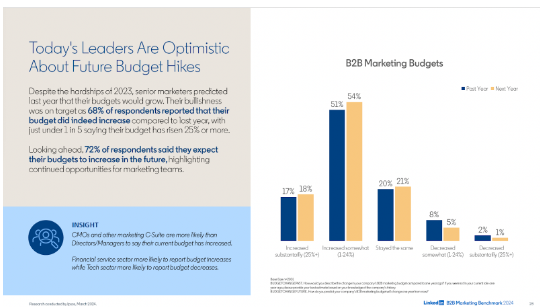
Source: 2024 B2B Marketing Benchmark
#7. Get other industry experts involved: Data from a single voice is interesting, but a consensus of thought leaders backing up that data? That’s compelling! Partnerships can be accomplished through co-branded research, or by including quotes and feedback from experts.
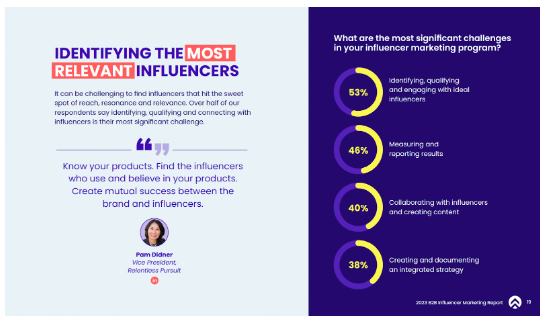
Source: 2023 B2B Influencer Marketing Report: Elevate & Ignite
#8. Give your audience actionable takeaways: Data is great, but useful insights are what drive impact and motivate organic sharing. Highlight key findings and suggest practical applications that can help your audience use the insights to inform their strategies.
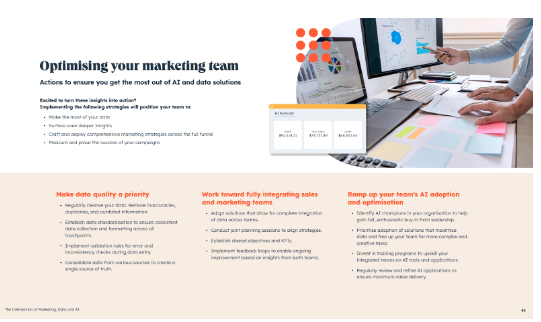
Source: The Intersection of Marketing, Data and AI
#9. Prioritize the report design: Design can make or break your report’s readability. Make your research accessible and easy to digest by using a combination of visuals (infographics, charts) and detailed insights to present your findings.
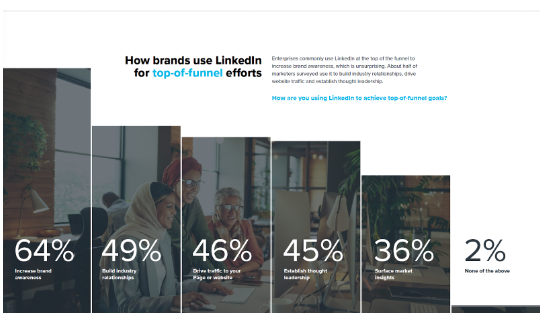 Source: Proving the Power of Brand
Source: Proving the Power of Brand
#10. Promote, promote, promote: Publishing a research report should never be a one-and-done campaign. Make sure you continue to leverage your research findings by promoting the report across various channels and through different content formats to reach a broader audience and maximize the impact of your research.
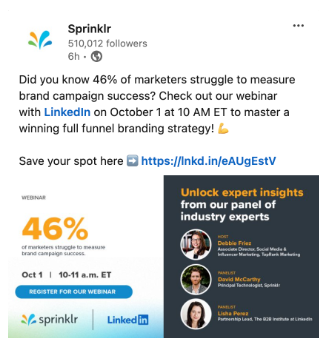
Our friends at Content Marketing Institute have also drafted an excellent self-assessment for marketers who are considering diving into original research: Don’t Start an Original Research Project Before Answering These 8 Questions.
Learn to stop worrying and love B2B original research
Publishing a marketing research report is an excellent way for your company to share the next Big Idea with your industry. At TopRank, we’ve helped companies bring their research to life, as well as published our own proprietary insights.
Some highlights from this last year of report drafting include:
Interested in learning more about how we can help you develop a marketing report based on original research? Contact us.

Comments are Closed